
Great Ecology Welcomes Damian Holynskyj
October 25, 2017
Emily Callahan & Amber Jackson Named to Forbes 30 Under 30
November 20, 2017by Liz Clift
Not too long ago, sand cat kittens were filmed for the first time, and the internet went gaga over the brief video—especially the portion of the internet that’s convinced the internet is for cats.
So, I pose this question to you: what could be better than cats wearing snowshoes?
Yes, these exist.
Well, sort of.
Canada lynx (Lynx canadensis) are a member of the cat family that lives primarily in boreal forests that receive high levels of snowfall—and so in the US are generally found in Alaska and in montane forested areas along the Canadian border; although, they can also be found in high elevations further south in the contiguous US. They have giant paws that help distribute their weight over the surface of the snowy areas in which they live—which allows them to more effectively pursue their prey.
Lynx populations—like many other predators—fluctuate in response to their food supply. Lynx primarily eat snowshoe hare (Lepus americanus), so when populations of snowshoe hare decrease, so do populations of lynx. Lynx typically have litters of up to five kittens, but particularly food-rich years and a fertile mother can lead to litters of up to seven. In years of scarcity, these litters are smaller, which helps keep populations in check (there’s no evidence of significantly higher adult mortality when prey populations are smaller).
Lynx populations are dependent on areas with stands of conifer (also a preferred habitat of snowshoe hares)—which are areas that can be disturbed by forest fire or landslides, but also human-caused disturbances such as mining, logging, and infrastructure or housing development, all of which can cause habitat fragmentation and loss. Additionally, with lynx, there’s evidence that competition from other predators can also impact lynx populations—and that this competition can be increased as other resources, including habitat, become scarcer.
This has implications for how we think about restoration—and how we think about development projects. Do we include wildlife corridors as a part of our planning process (even while development or logging or mining is happening)? Do we try to replicate natural patchiness upon restoration, and provide phased restoration work that will provide a mix of older and younger conifer forest? How do we best pay attention to all the factors that make up critical habitat for species of concern?
These questions are important for considering how this species can be de-listed (it was listed by US Fish and Wildlife Service as threatened in 2000). For this to happen, its population will need to continue to increase, which means we must work to negate habitat loss and fragmentation.
And we should do this because lynx provide economic benefits by controlling snowshoe hares and its other prey animals, which are considered agricultural and silvicultural pests, because these animals have evolved to be part of our boreal forest ecosystems, and because most of us want more cat videos on the internet.
